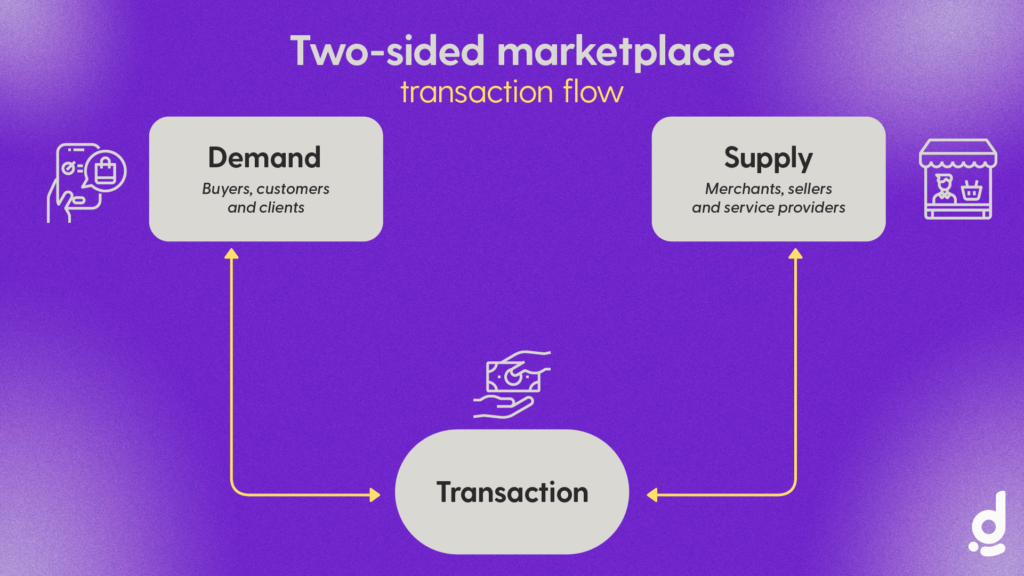
Learn – Dittofi News Must have features for your online marketplace platform. (2024) Discover the must-have features for your online marketplace platform. From buyer and

One question we get all the time is “can I build my marketplace on top of Shopify or Shopify Plus?”.
This is a very natural question to ask, since for ecommerce, Shopify has a reputation of being easy to maintain & the platform is very simple to use which is a big plus.
However, the ridged & locked down nature of Shopify’s ecosystem results in a lot of compromise.
In this article we investigate what are the pros & cons of building a multi-vendor marketplace on Shopify.
When analysing if Shopify is a good tool to build a multi-vendor marketplace, we look at what marketplace features Shopify has & compare these to essential functionality that is required by all marketplace solutions. The goal is to identify any gaps in Shopify as a marketplace solution. You can read more about the essential marketplace features in our article “must have features for your multi-vendor marketplace platform”.
After we’ve completed our gap analysis, we consider how easy & sustainable it is to extend Shopify to fulfil missing features. We then collect up our findings, document these & work with industry experts to verify our findings.
A multi-vendor or peer to peer marketplace is a platform where buyers & sellers can connect in order to transact. The marketplace platform acts like a middleman to help buyers & sellers easily find each other.
There are three main types of multi-vendor marketplaces: product, service & rental marketplaces. Famous examples of these marketplaces include Etsy, Upwork & Airbnb. To learn more about multi-vendor (peer to peer) marketplaces, read our complete guide to peer to peer marketplaces.

If you’re thinking about developing a marketplace with Shopify, the very first question you need to ask yourself is, is Shopify a marketplace platform? The answer is “No”. By design Shopify is not a marketplace platform. It is a platform for merchants to grow a standard ecommerce store. This means that it does not have the critical features required for a marketplace solution.
The second question to ask is “can you leverage some of Shopify’s functionality & turn it into a marketplace platform”. The answer to this question is “Yes”. However, a critical point is that marketplace features do not come out of the box & you will need to use some third party, multi vendor plugin.
Another key point to note is that whilst you may be able to bend Shopify to meet your version one requirements of a products marketplace, it will become increasingly complex to build new custom features for your marketplace.
In the next two sections, we will look at the:
In this section we cover some of the key benefits of using Shopify to build a multi-vendor marketplace.
The typical cost of building a multi-vendor marketplace from scratch requires an investment of $50,000 – $100,000. This is a lot of money to spend on building a new marketplace. It is also very hard to find a quality engineering team who will be able to help develop your marketplace.
Using Shopify to build a multi-vendor marketplace is faster & less expensive than building your marketplace from scratch. This is because you can leverage certain core components of Shopify to build your marketplace. All that being said, Shopify is not a marketplace solution & therefore you need to carefully architect your marketplace (more on this later). There are also alternative multi-vendor solutions that are better suited to marketplace development than Shopify.
Shopify is known for its ease of use including a user-friendly drag-and-drop website builder, a straightforward product & inventory management system, & a wide selection of pre-designed templates, making it accessible to users of varying technical backgrounds.
Shopify is also known for offering a seamless integration of essential e-commerce functionalities, like payment processing, order management, & shipping, in one platform, reducing the complexity of managing multiple systems & simplifying the user experience.
However, these benefits apply only to ecommerce stores. As we shall see, shipping functionality is not supported for multi-vendor marketplaces built on Shopify.
Shopify provides tools and features to help with marketing and search engine optimization (SEO), making it easier to attract customers and grow your marketplace’s visibility.
Shopify offers a very rigid & locked down ecosystem that makes it challenging to develop a multi-vendor marketplace using Shopify. In this section we break down these include that include:
In the rest of this section, we take a deep dive into these challenges.
Shopify cannot perform the majority of tasks required for a two-sided marketplace. This means that management of sellers, products & orders cannot be fully handled within Shopify itself. Instead, you will need to do these tasks externally & then interact with Shopify using special tools called APIs (Application Programming Interfaces).
The concern here is that Shopify places limits on the number of requests that you can make to its system via an API. This limitation is set at 4 requests per second. As such, if you send too many requests to Shopify in a very short period of time, you’ll hit a roadblock & Shopify will not respond to your requests. If this happens, your marketplace users will be forced to wait until the requests resolve.
It’s like waiting for a slow elevator – if only a few people can use the elevator at a time, everyone else has to wait, & it feels frustrating when you just want to get to your destination quickly. In a similar way, rate limits slow down the flow of information between the user interface & backend of your marketplace. Users experience delays, loading times, & unresponsiveness, which can be annoying & lead to a poor experience.
You will start to notice the impact of rate limits as you start to scale. For example, if you have just 240 simultaneous users of your Shopify backed marketplace, each user will need to wait 1 minute for the frontend of your marketplace to respond to their clicks. This is obviously going to make your marketplace almost entirely unusable.
If you want to use Shopify, you can avoid these rate limits but then you need to plan your operations carefully. This means organising & scheduling your requests in a way that doesn’t overwhelm Shopify. If you plan to go this route, it’s best to hire experts who have dealt with these issues before.
Alternatively, you can use a solution like Dittofi that allows you to build an entirely custom marketplace without having to interface with third party solutions that impose rate limits.
Since Shopify was originally designed as a one sided, ecommerce solution, building a two-sided marketplace on their technology can be messy. Certain marketplace features may be technically possible however may introduce hacky, complex “spaghetti code” solutions that become difficult to maintain, make building new features hard & risk degrading the shopping experience.
In contrast, Dittofi’s purpose built marketplace solutions allow you to generate simple, clean & efficient code on a modern technology stack. Modifications made to the code are done through Dittofi’s visual development studio which ensure clean & scalable code, with or without a developer.
The way Shopify handles tax is not very flexible. Using the Shopify product, you can control the tax rates at a sitewide level. It is possible to build a more dynamic approach that updates according to different jurisdictions however, not without introducing third party technology or custom developed solutions which can get expensive.
Shopify doesn’t meet marketplace requirements for shipping.
This is because, whilst sellers can select predefined shipping rules, it is very difficult to allow sellers to define their own custom shipping rules. This option is important for product marketplaces where shipping is a differentiator used by sellers to stand out on the marketplace. For instance, product marketplace Etsy says:
In this case, there are Shopify apps that you can use to make shipping models more dynamic; however these can add additional costs & dependency to your marketplace.
In contrast, platforms such as Dittofi allow you to quickly & easily add options for custom shipping on top of prebuilt marketplace templates & without having to write any code.
Shopify does not have a native returns management system.
This means that you will need to integrate with a third party return management system such as Loop Returns, aftership, Bold returns manager etc. However, these solutions are focused on providing returns management for ecommerce platforms. They do not support marketplace returns. This means that a marketplace admin will need to manually reconcile returns with sellers. This manual process will work while the marketplace is small however, developing an automated returns process that handles admin & communication between the buyer, the seller & the platform provider is a major add on to the Shopify marketplace solution.
By contrast, you can quickly adapt any of Dittofi’s marketplace templates to quickly & easily develop a customised returns experience for your marketplace.
A critical component of all two-sided marketplaces is in app messaging & notifications. Each message & notification should be linked to a transaction. By encouraging marketplace users to communicate on platform, this can help marketplace operators resolve disputes around transactions, provide additional value through their platform & reduce marketplace leakage.
Shopify multi-vendor solutions do not support messaging & notifications related to a particular transaction. Adding this feature is challenging, especially when you are bound by Shopify’s existing code structure & way of doing things.
By contrast, marketplace software like Dittofi’s marketplace solutions has in-app messaging that runs on highly efficient code, comes with audit trails & admin panel for dispute resolutions & can be further customized if needed.
Other areas that Shopify does not support well but that are important are:
You cannot build a multi-vendor marketplace with only Shopify. You will need to augment Shopify with custom developed solutions or third party software. As we have seen, this leads to various challenges & a suboptimal product.
All that being said – development agencies & freelancers will often recommend Shopify as a solution. This is because it is what they know. Nowadays there are marketplace technologies such as Dittofi, Sharetribe or Mirikl that have been designed to help you build a marketplace in a better way. However, if your heart is set on using Shopify to build your marketplace, in this section we give you some ways that you can achieve it.
The options include:
For the shortest amount of time to start selling products, you can take a more manual approach to setting up your marketplace on Shopify. In this case, you don’t even need to have one of Shopify’s multi-vendor plugins installed.
Sellers can simply email over CSV files of products or services. Your platform admin can then input each item into Shopfiy to create a listing. The platform will then behave exactly like any other ecommerce platform & all commercial aspects will be handled manually & separately via an agreed process. Any product recommendations, upsells & so on could be handled by an administrator in the same way.
This is the quickest & lowest cost way to build a multi-vendor marketplace on Shopify, however it is heavily limited, very manual & should only be considered for a very basic proof of concept (MVP) solution.
It is possible to improve on the manual approach, by using 3rd party tools to automate any of the manual steps. One tool you could use would be a Product Information Management (PIM) system such as Akeneo or Pimberly.
These solutions provide an interface for sellers to login & perform their required listing management without needing to rely on an admin. Using a PIM system combined with a standard Shopify solution sellers could then create, update & delete listings, edit their stock levels & so on, all by themselves. For large sellers, you could even allow sellers the chance to connect up their ERP system to keep stock levels automatically in sync.
You could also enable shipping & tax rules to be integrated into the seller’s interface using platforms such as ShipperHQ & Zonos respectively. Finally, as we saw earlier, validating return requests can be done by using a platform such as Loop Returns.
Another option is to create your own custom coded solutions that you plugin to Shopify. For instance, you can build your own PIM system. This will give you the ability to create your own custom sellers interface. For example, you could allow sellers the flexibility to create their own shipping rules, handle advanced tax logic & so on. In this case, it’s better to check what the existing third party solutions are, what their costs are & how good a fit they are for what you need before coding something from scratch.
Last on our list is the Shopify multi-vendor plugin. There are a few multi-vendor plugins that you can consider to build a marketplace on Shopify. These plugins are developed by 3rd parties & give you an integration from a Shopify store to an interface outside of Shopify for sellers to manage their products & orders. This is a quick & easy option but, with limited flexibility or reliability at scale.
Will Shopify enable you to build a two-sided marketplace? The answer is yes. However, you will need a skilled team that has experience building marketplaces at scale with Shopify to make this work. Without the correct team, you’ll end up with a slow marketplace that requires a huge amount of manual work to run. This will decrease your revenue & lower your profit margins. It is a mistake to think that using Shopify to build a multi-vendor marketplace is a quick & easy process – it is not & will require either manual processes or third party & custom coded solutions to be successful.
In contrast, specialist marketplace solutions such as those developed by Dittofi will enable you to rapidly develop an entirely custom marketplace without having to write any code. With technologies like Dittofi, you can start with a completed product, service or rental marketplace. You can then customize your marketplace using Dittofi’s visual development studio, without writing any code & then scale up your marketplace technology using Dittofi’s enterprise grade architecture & scale up your marketplace operations by building more apps using Dittofi.
Check out examples of Dittofi’s marketplace solutions or schedule a call with one of our marketplace experts today to discuss further.

Learn – Dittofi News Must have features for your online marketplace platform. (2024) Discover the must-have features for your online marketplace platform. From buyer and

How to come up with a great idea for an online marketplace [2024] By James Virgo Table of Contents Online marketplaces offer several highly scalable

Dittofi Idea Validation Board By James Virgo App development happens in ordered phases. These phases are shown in the graph below. Image: The phases of app

Enter your email below and we will email you a free copy of one of our best guides (28 pages)
Enter your email below and we will email you a free copy of one of our best guides (28 pages)
⸺ Receive the latest news
Get notified about new articles and events